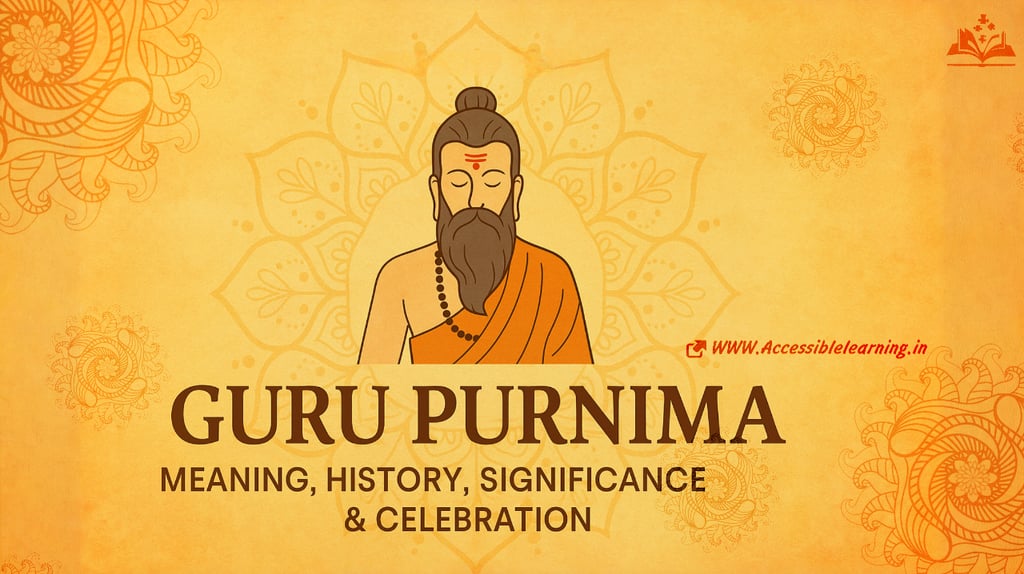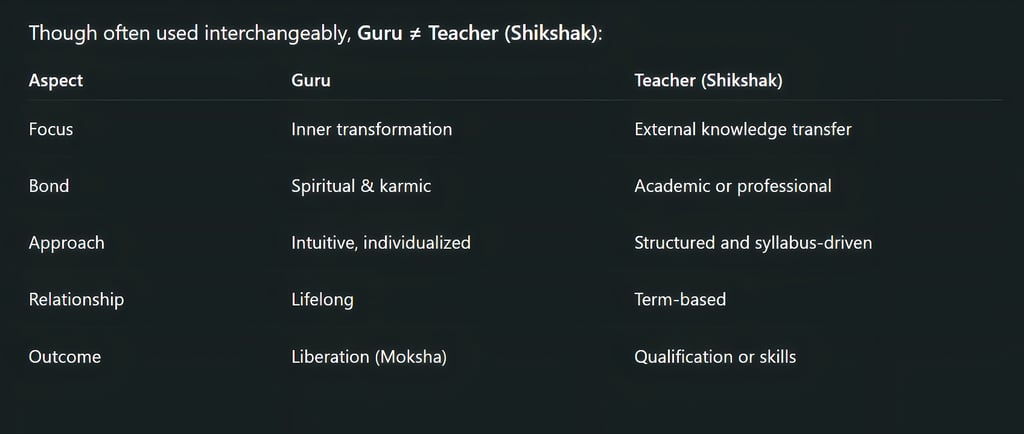
Guru Purnima 2025: Meaning, History, Significance & Celebration
Celebrate Guru Purnima 2025 by exploring its deep spiritual meaning, historical roots, rituals, and modern relevance. Learn how this sacred day honors mentors, spiritual guides, and the timeless Guru-Shishya tradition across cultures.
CULTURE/TRADITIONEDUCATION/KNOWLEDGEINDIA/BHARAT
Keshav Jha
7/8/20255 min read


Guru Purnima is more than just a festival—it's a soulful tribute to the mentors, teachers, and spiritual masters who shape our minds and guide our journeys. Celebrated on the full moon (Purnima) of the Hindu month of Ashadha (usually in June or July), this day marks a spiritual alignment between knowledge, gratitude, and tradition.
In 2025, Guru Purnima will be celebrated on July 10. From ancient ashrams to modern classrooms, this day unites millions in honoring those who illuminate the path of wisdom.
What is Guru Purnima?
The word “guru” is derived from Sanskrit—“Gu” meaning darkness and “Ru” meaning remover. Hence, a Guru is the “remover of darkness,” one who leads from ignorance to awareness.
Purnima means full moon, symbolizing completeness and divine light. Together, Guru Purnima is a day to express reverence to one's Guru, whether spiritual, academic, or philosophical.
Historical Roots: Why Guru Purnima is Celebrated
Tribute to Sage Vyasa
Guru Purnima is traditionally celebrated as the birth anniversary of Sage Ved Vyasa, the revered author of the Mahabharata and compiler of the Vedas. He is often considered the Adi Guru—the first teacher in Hindu tradition.Buddhist Significance
For Buddhists, this day commemorates the moment when Buddha Ji gave his first sermon at Sarnath after attaining enlightenment. Thus, it marks the foundation of the Sangha (community) and Buddhist teaching.Jain Observance
Jains honor Mahavira Ji, who made Indrabhuti Gautam his first disciple on this day—another symbol of spiritual guidance.
Spiritual Significance of Guru Purnima
In Hinduism and many Eastern traditions, spiritual knowledge is not merely academic—it's transformative. The Guru serves as a bridge between the finite (self) and infinite (divine).
Guru Purnima is the ideal time to reconnect with one’s inner self, offer gratitude to mentors, and renew one’s spiritual goals. Many seekers begin or deepen their sadhana (spiritual practice) on this day.
Rituals & Traditions: How is Guru Purnima Celebrated?
Offering Respect to Gurus
Students and disciples visit their teachers with flowers, sweets, or symbolic gifts.
Spiritual seekers perform Paduka Puja (worship of the Guru’s feet) and chant Guru Stotra or mantras like:
"Guru Brahma, Guru Vishnu, Guru Devo Maheshwara..."
Fasting and Meditation
Many devotees observe fasts or consume sattvic (pure) food to purify the body and mind.
Long sessions of meditation, yoga, and prayer are conducted in ashrams and homes.
Scriptural Readings & Discourses
Sacred texts like the Bhagavad Gita, Upanishads, and Yoga Sutras are studied.
Gurus may give discourses or share personal teachings and spiritual insights.
Global Celebrations
Indian communities across the world—from the US to Malaysia—host Guru Purnima events, satsangs (spiritual gatherings), and online webinars to honor this tradition.
Modern-Day Relevance of Guru Purnima
In today’s fast-paced, digital world, the concept of a Guru has evolved—but its essence remains unchanged. Teachers, life coaches, spiritual mentors, therapists, parents, and even books can be our modern-day Gurus.
Guru Purnima offers a pause, a chance to appreciate those who’ve made us better—whether by sharpening our intellect or healing our spirit.
Why Guru Purnima Matters More Than Ever in 2025
In an age driven by artificial intelligence, hyper-connectivity, and information overload, wisdom has become more valuable than knowledge. Guru Purnima reminds us that
Real growth is internal—beyond grades, metrics, or fame.
Gratitude nurtures humility, a virtue often lost in ambition.
Learning is lifelong, and there’s always a higher path to walk.

Symbolism of the Full Moon on Guru Purnima
The full moon (Purnima) on this day isn't just astronomical—it's deeply symbolic:
Represents mental clarity, illumination, and emotional completeness.
In yogic traditions, it’s believed that the human energy system is most receptive during a full moon, making it the perfect time for initiation and introspection.
The full moon is also seen as the Guru in the sky, radiating the light of wisdom.
Guru Purnima & Yoga Tradition (Saptarishi Lineage)
In yogic culture, Guru Purnima is the day when Shiv Ji became the first Guru, or Adi Yogi, and began transmitting yoga to the Saptarishis (seven sages).
This transmission laid the foundation of Sanatana Dharma’s spiritual sciences.
The occasion is considered auspicious for receiving or deepening initiation into yogic practices, especially in ashrams like Isha, Art of Living, and Sivananda.
Regional & Cultural Variations Across India
While the core essence remains the same, Guru Purnima is celebrated differently across India’s diverse cultures:
Maharashtra: Devotees honor Dnyaneshwar and Samarth Ramdas, prominent saints and spiritual Gurus.
Uttar Pradesh & Bihar: Celebrations are deeply linked to Sage Vyasa and Guru-disciple traditions in Vedic learning centers.
Tamil Nadu & Kerala: The day is linked with Advaita philosophy and remembrance of Adi Shankara.
Nepal: Known as Teacher’s Day (Guru Vandana Din) and celebrated in both Hindu and Buddhist traditions.
Himalayan belt (Sikkim, Ladakh, Bhutan): Tibetan Buddhists observe it with special teachings and meditations by senior Lamas.
Digital Era Celebrations: Tech Meets Tradition
In the post-pandemic, digitally connected era, Guru Purnima has seen a transformational shift:
Online Satsangs, YouTube livestreams, and Instagram lives by Gurus and spiritual institutions are now common.
Platforms like Zoom, Telegram, and even Clubhouse host spiritual Q&As and virtual discourses.
People create personal gratitude reels or digital thank-you messages for their mentors, reaching a broader audience.
This shows how ancient reverence adapts gracefully into modern modes of expression.
Psychological & Emotional Relevance of Guru Purnima
Guru Purnima offers a unique space for emotional healing and cognitive reflection.
Encourages people to reflect on life lessons, showing how far they've come due to someone’s influence.
Triggers emotional gratitude, which is scientifically known to reduce stress and enhance well-being.
In therapy and personal development, the “inner Guru” or higher self is often invoked for healing and intuition.
Guru Parampara—The Unbroken Lineage
Guru Purnima also honors the Guru-Shishya Parampara (Master–Disciple lineage):
It’s not just about individual Gurus but the entire succession of wisdom holders.
Traditions like Nath Sampradaya, Advaita Vedanta, the Bhakti Movement, and Tantric schools uphold this chain.
Many ashrams conduct ceremonies to honor the lineage—sometimes going back thousands of years.





How to Celebrate Guru Purnima If You Don’t Follow a Religion
Guru Purnima is inclusive and universal. Even if you're not religious, here’s how you can celebrate it meaningfully:
Write a letter of gratitude to someone who changed your life.
Spend time in self-reflection, honoring lessons life has taught you.
Share a post or blog appreciating your role models or thought leaders.
Begin a new habit, discipline, or personal ritual as a way to honor growth.
Guru Dakshina—The Offering of Gratitude
Traditionally, disciples offer Guru Dakshina—a token of respect or service to the Guru. Today, this can take many forms:
Volunteering for a cause supported by your mentor.
Donating to a knowledge-based initiative or educational project.
Practicing the Guru’s teachings sincerely and passing on the wisdom.
As the ancient saying goes:
“The best Dakshina is to live the teaching.”
Powerful Quotes to Reflect Upon This Guru Purnima
“Let no man in the world live in delusion. Without a Guru, no one can cross over to the other shore.” – Guru Nanak
“The Guru is the bright lamp that dispels the darkness of ignorance.” – Adi Shankaracharya
“If I have seen further, it is by standing on the shoulders of giants.” – Isaac Newton
FAQs
Q. Is Guru Purnima a public holiday in India?
It is not a national public holiday, but many educational and spiritual institutions may observe it.
Q. Can one celebrate Guru Purnima without a spiritual Guru?
Yes. You can reflect on and honor any figure who has significantly impacted your life—mentors, parents, teachers, or role models.
Q. How is Guru Purnima different from Teacher’s Day?
While Teacher’s Day celebrates academic instructors, Guru Purnima holds spiritual and philosophical significance, extending beyond formal education.
Guru Purnima 2025 is not just a ritualistic observance—it’s a personal pilgrimage. In remembering our Gurus, we remember who we truly are. Whether you're on a spiritual path or simply grateful for someone who changed your life, take a moment to honor that guide.
Because behind every illuminated mind, there’s a Guru who lit the flame.
Subscribe To Our Newsletter
All © Copyright reserved by Accessible-Learning Hub
| Terms & Conditions
Knowledge is power. Learn with Us. 📚


